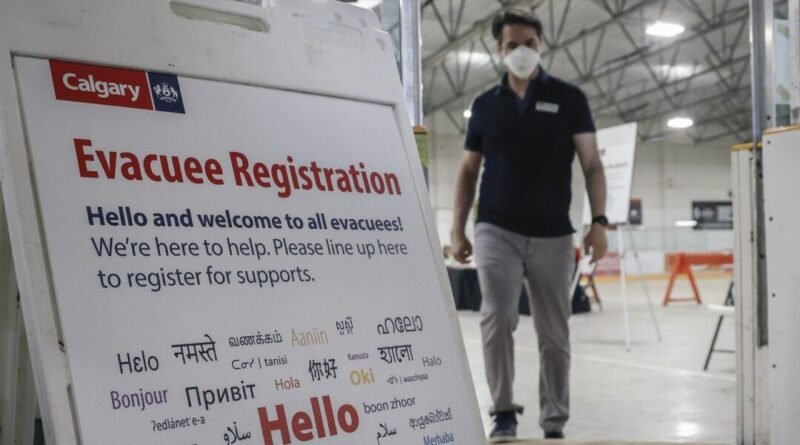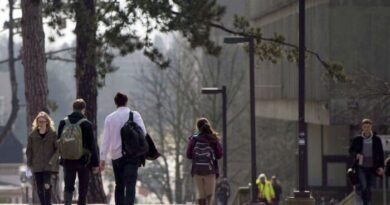Townsite of Jasper Evacuated as Wildfire Approaches and First Responders Withdraw
One of two raging, wind-whipped wildfires bearing down on the historic Jasper townsite reached its southern outskirts early Wednesday night as a last-ditch attempt to reroute it failed.
Around the same time, all first responders were ordered out of Jasper National Park for their safety and to give fire crews more room to operate.
Firefighters remained in the town to douse spot fires and maintain sprinkler lines. Everyone else was reminded to get out.
“If you have not yet evacuated town you must leave now,” Katie Ellsworth, with Parks Canada, said in a statement posted on Facebook.
“Our hearts go out to all of the affected community members, their families and their friends, many of which include our local first responders.”
The northern fire was spotted five kilometers from Jasper earlier in the day.
The southern fire had been reported eight kilometers distant from the town, but Ellsworth said strong wind gusts swooping in behind it sent it racing.
Everything that could go wrong did go wrong as fire perimeters changed minute by minute.
Ellsworth said bucketing efforts by helicopter failed.
Crews using heavy equipment to build fireguards couldn’t complete the work before having to pull back for safety.
Water bombers couldn’t help due to dangerous flying conditions.
A last-ditch effort to use controlled burns to reroute the fire to natural barriers like Highway 16 and the Athabasca River failed due to “unfavourable conditions.”
The hope was that up to 20 mm of rain, forecast to begin falling in the area later Wednesday night, would bring some relief.
Ellsworth said the decision to relocate all first responders to the town of Hinton, just outside the eastern edge of the park, “has not been made lightly.”
She said, “Given the intensity of fire behaviour being observed the decision has been made to limit the number of responders exposed to this risk.”
Alberta Forestry Minister Todd Loewen asked the Canadian Armed Forces for help.
“We are requesting firefighting resources, aerial support to move wildfire crews and equipment and more,” Loewen wrote on the social media platform X.
About 5,000 people live in Jasper. They, along with about 20,000 park visitors had to flee on a moment’s notice Monday night when the fires flared up.
The order to go went out around 10 p.m. Monday as fires cut off road access to the Jasper townsite from the east and the south, forcing evacuees to drive west into British Columbia in a long, slow midnight cavalcade through swirling smoke, soot and ash.
The following day, evacuees in B.C. who didn’t have a place to stay were directed to make a long, looping U-turn around the fires back to Alberta to evacuation centers in Grande Prairie and Calgary.
B.C., dealing with its own multiple wildfires and evacuees, did not have the capacity to help Alberta, officials said.
At the Grande Prairie evacuation center, Addison McNeill recalled literally just arriving in Jasper when she was told to get out.
McNeill said she had just put her bags down after moving from Edmonton for her new job as a line cook when she got an alert on her phone that she needed to leave immediately.
“I moved there two hours before the evacuation notice,” said the 24-year-old in an interview.
McNeill said went to a nearby hotel, one of two meet-up points for those without transportation. She hopped in a recreational vehicle with others and headed out — at a snail’s pace.
“Every single person in town was beelining to one exit from about six different routes and so you get bottleneck, backups and congestion,” she said.
McNeill said as she sat inside the vehicle, she felt so close to the wildfires that the windows seemed like they were going to shatter from the pressure of the red, hot, smoky air.
She saw acts of kindness amid the swirling ash: neighbors loaning their cars to those without; people knocking on doors to see if everyone inside was OK.
“It was far from a panic,” she said.
Jasper National Park, the largest in the Canadian Rockies, is considered a national and international treasure.
The United Nations designated the parks that make up the Canadian Rockies, including Jasper, a World Heritage Site in 1984 for its striking mountain landscape.
It has hosted glitz and glitter. In 1953, Hollywood star Marilyn Monroe visited to make the movie “River of No Return.” More recently, the TV show “The Bachelor” was filmed there.
Jasper is famous for hiking, skiing, kayaking, and biking.
It is also home to dozens of species such as elk, mountain goats, cougars, lynx, black bears, and grizzly bears.





